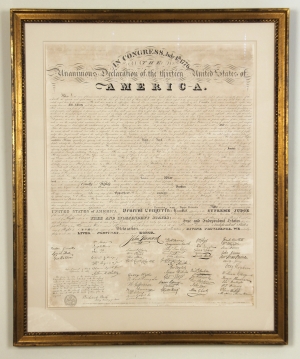|
Declaration of Independence: Benjamin Tyler 1818 - First Print with Facsimile Signatures |
Click to enlarge:

“In Congress, July 4th 1776. The Unanimous Declaration of the thirteen United States of America.”
BENJAMIN OWEN TYLER.
Broadside, Drawn by Tyler and engraved by Peter Maverick, [Washington, D.C., 1818]. 1 p., 23⅞ x 31 in., archivally framed to approx. 32 x 40 in.
Inventory #23683
SOLD — please inquire about other items
Historical Background
Tyler’s engraving of the Declaration was the first such decorative print with facsimiles of the signatures, based on the original manuscript. Tyler, a penmanship professor, copied the signatures by hand. The exactness of his work is particularly impressive given the limitations of copying them freehand. Richard Rush, son of the signer Benjamin Rush, and acting Secretary of State in 1817, gave his endorsement which is printed on the bottom left corner: “The foregoing copy of the Declaration of Independence has been collated with the original instrument and found correct. I have myself examined the signatures to each. Those executed by Mr. Tyler are curiously exact imitations, so much so, that it would be difficult, if not impossible, for the closest scrutiny to distinguish them, were it not for the hand of time, from the originals.” More importantly, Tyler also won the endorsement of the author of the Declaration, Thomas Jefferson, to whom his edition is dedicated.
The Albert and Shirley Small Special Collections Library of the University of Virginia provides background on the Tyler printing:
In 1815, the United States concluded its second war with Britain, the War of 1812, and American nationalism blossomed in its wake. Reinforcing this renewed patriotism, the passing of the signers’ generation created a passionate interest in all things associated with the nation’s founding. Several entrepreneurs sought to capitalize on this demand by rushing to produce the first facsimile printings of the Declaration of Independence—offering the American public its very first look at the document.
In 1818, Benjamin Owen Tyler produced the first facsimile of the Declaration - an elaborate, painstakingly hand-copied engraving.[1]
The book which Tyler used to take orders for his facsimile survives, in the Albert H. Small Declaration of Independence Collection. Thomas Jefferson, James Madison, John Quincy Adams, and other notables were among those who signed the book. We count roughly 1694 copies sold on paper, 40 on vellum, and 3 on silk and 3 on linen.
Tyler’s business rival John Binns had started more than a year earlier, but his monumental illustrated engraving was not published until the next year. The next and most desirable print of the Declaration came five years later, when W.J. Stone produced a truly exact facsimile of the entire document.
Benjamin Owen Tyler (1789-aft. 1855) was born in Massachusetts and grew up in Vermont. He moved to New York City around 1814, where he taught penmanship and stenography and did ornamental writing for diplomas and other documents. Tyler married Anna Maria Payne (1795-1848) in Albany, New York, in November 1815, and they had at least four children, only one of whom survived. In 1816, Tyler also taught penmanship at the U.S. Military Academy at West Point. He moved in January 1817, to Washington, D.C., where he taught handwriting and produced engraved portraits of famous Americans and created facsimiles of their letters. In 1818, he published what he considered the “first correct copy” of the Declaration of Independence. When he visited Monticello, he taught Thomas Jefferson’s granddaughters how to improve their writing and “make pens scientifically.” In 1820, he opened a lottery office in Washington with branches in other northeastern cities and operated it for a decade. He left Washington in 1830 and lived “in various parts of the United States and the Canadas,” before returning briefly to Washington in 1834. When he returned, he offered some of his previous productions, as well as a few copies of his Declaration of Independence printing with facsimile signatures. He returned to the capital again in 1838, when he sold paintings and preserved paintings, drawings, and maps with a varnish invented by his wife. In 1840, Tyler created a pair of broadsides supporting the candidacy of Whig William Henry Harrison for president. In January 1855, Tyler was found “grossly intoxicated” in Boston and sent to jail. He had to pay a fine of $5 for public drunkenness.
Condition
Margins trimmed close, just touching one or two flourishes; scattered insect damaged with five very small holes but text virtually complete; cleaned with some repaired tears and smoothed wrinkles; attractive overall.